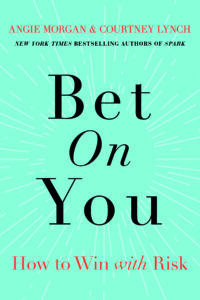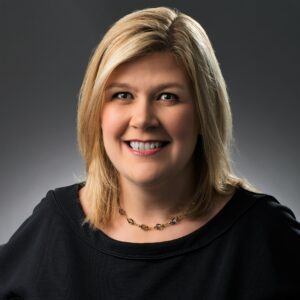Do you play it safe?
Do you play it too safe?
What’s your appetite for risk?
In Bet on You: How to Win with Risk, authors Angie Morgan and Courtney Lynch tackle the topic of risk. From the misconceptions of risk to teaching how to build risk muscle and mitigate the downsides of risk, they offer a compelling, thoughtful, and helpful life book that will help you both in business and in life.
I recently spoke with Courtney about their book.
How do you define risk?
We define risk as taking action in the face of uncertainty. Since none of us can predict the future, that means risk and uncertainty are always fully present in our lives. You begin to grow comfortable with the concept of risk-taking when you acknowledge this truth. It will help you be more open to inviting risk into your life strategically, instead of working continuously to eliminate it.
What do we often get wrong when we think about risk?
A common misconception about risk is that it’s the opposite of reward. In reality, risk is the only path that leads to growth, opportunity, self-direction, transformation, and positive change.
Warming up to risk can be difficult because the word risk is often used synonymously with danger, peril, liability, or threat. However, these words represent only one narrow side of the story. By initiating risk-taking and inviting uncertainty into your life, you’re in a better position to become more comfortable being uncomfortable, as well as influence your life’s direction. One thoughtful risk will inevitably lead to another, and as you build your risk muscle, you’ll be strengthening your risk capacity.
You start the book talking about how we teach kids to play it safe. What tips do you have for parents who want to encourage appropriate risk taking?
 Children take their early cues on risk responses from their parents. If parents are always hovering about or get anxious about the child’s actions and are consistently fearful of something- kids pick up on that and it can contribute to becoming risk adverse as an adult.
Children take their early cues on risk responses from their parents. If parents are always hovering about or get anxious about the child’s actions and are consistently fearful of something- kids pick up on that and it can contribute to becoming risk adverse as an adult.
To support parents in helping their children right size risk I would encourage them to note how often and intensely they express worry and fear around their kids. In the early years this often shows up on the playground- if your child climbs to new heights on a slide or monkey bars, are you encouraging and supportive or are you nervous and restrictive?
As your child ages and seeks to try new activities, perhaps they want to run for student government, try a new sport or go on a school trip, do you encourage them with support and hope? Or are you quick to point out the downsides of their choices or interpret their interest through your own risk adverse profile by sharing your feelings of apprehension or nervousness? Instead, work to mirror your child’s confidence and interest in exploring.
If you meet someone who is clearly so risk avoidant that they are not winning, what strategies do you recommend they employ to break out from this pattern?
Angie and I wrote Bet on You: How to Win with Risk in response to coaching thousands of leaders and noticing in that process that many talented leaders often lack the one critical skill set that always leads to breakthroughs: The consistent ability to bet on themselves.
When we come across someone who is risk avoidant, we encourage them to:
Rethink how you view risk.
Risk in business or in life is not about big bold leaps. Risk done right is a series of steps—one, followed by many more—that are measured, thoughtful, intentional, well-planned, and require incremental action, not sudden jumps.
Identify your holdbacks.
Explore these key queries: Why haven’t you been successful yet at taking the first step or completing a critical milestone on the way to pursuing an important goal or passion? Is it . . .
- Timing—a.k.a., “Now’s not the right time.”
- Money—as in, there isn’t enough?
- Someone else—you don’t have the support of a critical stakeholder?
Or, is your hold-back internal:
- Your fear of mistakes and failure?
- An inability to prioritize?
- You don’t have faith you can follow through?
- A past failure that has shaken your confidence?
There could be other hold-backs, too, of course. To bet on yourself, you need to understand what’s holding you back.
In the decades we’ve committed to supporting leaders, we’ve yet to meet any professional whose dreams were beyond their capabilities. Instead, we’ve met many who’ve allowed fear, worry, and insecurity to dim their ability to envision success that matters deeply to them and prevent them from taking the steps necessary to live that life. Fear kills more dreams than failure ever will.
Save your “perfect” for never.
The fear of imperfection can invoke procrastination at best and stop a dream in its track at worst. When it comes to betting on you, abandon your perfectionist goals. They’re futile and unrealistic. Instead, plan and prepare for the goals you’ve identified for yourself with reality in mind. Strive for good enough. Good enough is a reliable gateway to the path to greatness.
Build a strong safety net.
We do brave things when we feel safe. A well-woven safety net gives you the confidence to keep stepping toward risks that matter, rather than be fearful of new or different opportunities. Three key elements weave together to create a stable foundation:
Your finances: Know what you need financially to achieve your goals. Yet don’t buy too far into a need for security to the point that you deny yourself a richer life. Be bold when it comes to investing in experiences to build the skills, awareness, and lessons you’ll use far into the future.
Your talent: It’s easy to believe that a job is part of your safety net. In reality though, it’s your performance and ability to meet and exceed standards that keeps you employed. It’s not the position, it’s how you grow, contribute, and perform in the role. Take consistent initiative to build your talent.
Your judgment: Wisdom comes from curiosity and learning. Proactively seek to learn from the experiences of others. Mine your own experiences for lessons learned. When making difficult choices connect with your values. Judgment absent your values leads to bad things.
Realize when you’re winning.
We exist in an achievement-oriented world; one in which winning is framed as fleeting and only attainable in us-versus-the-world moments when we’re either defying the odds or conquering something or someone else.
The problem with the societal definition of winning is that it’s overly focused on glory—not happiness, joy, contentment, and other winning qualities that are life enhancing, as well as both possible and achievable each and every day. You need this broader type of winning; it fuels your confidence and allows you to experience fulfillment. Plus, it motivates you to continue to embrace intentional risk well.
You tell many people’s stories in the book, including your own. Would you share one that gives our audience insight into your principles?
The story of Reese Witherspoon highlights the transformative power of risk-taking. At age 36, The New Yorker added her to a list of has-been actors. She was taken aback by what she believed was a premature death knell being sounded on her career. Instead of lamenting about how the Hollywood game was played, she chose to reinvent the game. She started a production company, Sunshine Media, to option rights to books she loved. This allowed her to produce films with interesting characters for her and other talented actors. She focused her business on her values of equity and diversity and her believe that it is important to share the tangible rewards from success with her employees. Her ability to embrace risk by reinventing her career paid off. Not only has she added value to the teams she employs and millions of fans of her projects, but she also recently sold Sunshine Media for a reported $900 million. She will continue to be involved in the company’s creative works.
For more information, see Bet on You: How to Win with Risk.
Boost Your Positive Intake
Image Credit: Loic Leray

